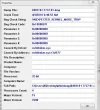- Thread Author
- #1
I'll try and keep this as brief as possible.
I have a dual boot system (Windows 7 and Xp Pro Sp3) on separate HDDs.
About a week after installing Nvidia driver 197.13, I booted in to 7, and my resolution was 640 x 480 with no other resolutions available. I have an EVGA GTX 275.
I uninstalled, and reinstalled the video drivers, rebooted, and got a BSOD.
Could boot in to Safe Mode, and my GTX 275 is recognized in Device Manager, as well as driver version.
Since then I have:
Reverted to an image I made about a week before the problem. (Image had same video driver version 197.13).
Reinstalled Windows 7 32 bit. BSOD before I even get to the Desktop.
Installed Windows 7 64 bit. Same result as above.
Scanned all hard drives with:
Malwarebytes Anti-Malware
Avira AV
SuperAntiSpyware
Avira Linux Rescue CD
No Malware found on any.
Tried Archived Nvidia driver v196.21, BSOD.
Installed my old video card (7900GTO)
No BSOD. I can get in to Windows 7, but when I first log on, the screen is just a bunch of diagonal lines.
This lasts for about 15 seconds and then clears up.
If I run any 3D graphics, again, nothing but diagonal lines. I have to Alt-F4 out of the program running the graphics to get my Desktop back. If I open the Nvidia Control Panel, my screen blacks out momentarily.
Tried a different power supply (with GTX 275). Same problems
Tested HDDs with HDTune and ran MemTest. No problems reported on either.
Installed Vista (Home Premium) on Windows 7 disk (with my GTX 275), and everything is fine.
Same with XP, all is fine with the GTX 275.
Ran ATI-Tool in XP, and Nvidia's Cascade in Vista, and the GTX 275 is working just fine.
Analyzed the memory dump from Windows 7 and: "Probably caused by : nvlddmkm.sys".
I Googled that, and found similar cases, but no solutions.
I thought this might be a hardware problem, but the card works fine in Vista and XP.
Does anyone have any idea what might be causing the BSOD's in Windows 7?
Any help would be appreciated. I'm out of ideas.
Specs:
MoBo: Gigabyte EP45-UD3P Bios vF10 (newest version)
CPU: Q9550 (no OC)
Cooler: Arctic 7 Pro
Video Card: EVGA GTX 275 896 MBs (no OC) (Now using a 7900 GTO)
RAM: GSkill DDR 2 1066 (PC2 8500) 2x2GBs (no OC)
HDDs: XP Disk-WD Velociraptor 150GBs, Windows 7 Disk-WD Black 640 GBs, Data Disk-WD Black 750 GBs
Optical Drives: LITE-ON Black SATA DVD-ROM, SAMSUNG 22X DVD±R DVD Burner
PSU: Corsair 650W
275 GTX Idle Temps w/SpeedFan (logged into XP):
GPU: 44C
Core 0: 30C
Core1: 34C
Core2: 32C
Core3: 34C
HD0: 38C
HD1: 30C
HD2: 37C
Core: 44C
Ambient: 38C
275 GTX Idle Temps w/RealTemp (logged into XP):
GPU: 44C
Core0: 30C
Core1: 34C
Core2: 32C
Core3: 34C
I have a dual boot system (Windows 7 and Xp Pro Sp3) on separate HDDs.
About a week after installing Nvidia driver 197.13, I booted in to 7, and my resolution was 640 x 480 with no other resolutions available. I have an EVGA GTX 275.
I uninstalled, and reinstalled the video drivers, rebooted, and got a BSOD.
Could boot in to Safe Mode, and my GTX 275 is recognized in Device Manager, as well as driver version.
Since then I have:
Reverted to an image I made about a week before the problem. (Image had same video driver version 197.13).
Reinstalled Windows 7 32 bit. BSOD before I even get to the Desktop.
Installed Windows 7 64 bit. Same result as above.
Scanned all hard drives with:
Malwarebytes Anti-Malware
Avira AV
SuperAntiSpyware
Avira Linux Rescue CD
No Malware found on any.
Tried Archived Nvidia driver v196.21, BSOD.
Installed my old video card (7900GTO)
No BSOD. I can get in to Windows 7, but when I first log on, the screen is just a bunch of diagonal lines.
This lasts for about 15 seconds and then clears up.
If I run any 3D graphics, again, nothing but diagonal lines. I have to Alt-F4 out of the program running the graphics to get my Desktop back. If I open the Nvidia Control Panel, my screen blacks out momentarily.
Tried a different power supply (with GTX 275). Same problems
Tested HDDs with HDTune and ran MemTest. No problems reported on either.
Installed Vista (Home Premium) on Windows 7 disk (with my GTX 275), and everything is fine.
Same with XP, all is fine with the GTX 275.
Ran ATI-Tool in XP, and Nvidia's Cascade in Vista, and the GTX 275 is working just fine.
Analyzed the memory dump from Windows 7 and: "Probably caused by : nvlddmkm.sys".
I Googled that, and found similar cases, but no solutions.
I thought this might be a hardware problem, but the card works fine in Vista and XP.
Does anyone have any idea what might be causing the BSOD's in Windows 7?
Any help would be appreciated. I'm out of ideas.
Specs:
MoBo: Gigabyte EP45-UD3P Bios vF10 (newest version)
CPU: Q9550 (no OC)
Cooler: Arctic 7 Pro
Video Card: EVGA GTX 275 896 MBs (no OC) (Now using a 7900 GTO)
RAM: GSkill DDR 2 1066 (PC2 8500) 2x2GBs (no OC)
HDDs: XP Disk-WD Velociraptor 150GBs, Windows 7 Disk-WD Black 640 GBs, Data Disk-WD Black 750 GBs
Optical Drives: LITE-ON Black SATA DVD-ROM, SAMSUNG 22X DVD±R DVD Burner
PSU: Corsair 650W
275 GTX Idle Temps w/SpeedFan (logged into XP):
GPU: 44C
Core 0: 30C
Core1: 34C
Core2: 32C
Core3: 34C
HD0: 38C
HD1: 30C
HD2: 37C
Core: 44C
Ambient: 38C
275 GTX Idle Temps w/RealTemp (logged into XP):
GPU: 44C
Core0: 30C
Core1: 34C
Core2: 32C
Core3: 34C
